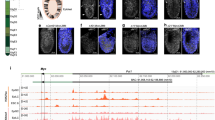Abstract
Transcription factors of the Maf proto-oncogene family have been shown to participate in the regulation of several differentiation specific genes. We previously reported that a member(s) of this family is involved in the regulation of the neuroretina specific gene, QR1, through a promoter region, designated the A box, that is closely related to the Maf recognition element (MARE). We undertook an identification of Maf family genes expressed in the quail neuroretina (QNR) and we report the isolation of mafA, a gene encoding a novel member of the large Maf proteins subgroup. Expression of this gene is developmentally regulated in the neuroretina. MafA is able to bind to MARE sequence and to heterodimerize with v-Maf, MafB, Jun and Fos, but not with the small MafF and MafK proteins. Accordingly, it is able to transactivate the QR1 promoter A box. We also show that increased expression of mafA induces sustained proliferation of postmitotic QNR cells.
Similar content being viewed by others
Author information
Authors and Affiliations
Rights and permissions
About this article
Cite this article
Benkhelifa, S., Provot, S., Lecoq, O. et al. mafA, a novel member of the maf proto-oncogene family, displays developmental regulation and mitogenic capacity in avian neuroretina cells. Oncogene 17, 247–254 (1998). https://doi.org/10.1038/sj.onc.1201898
Received:
Revised:
Accepted:
Published:
Issue Date:
DOI: https://doi.org/10.1038/sj.onc.1201898
- Springer Nature Limited
Keywords
This article is cited by
-
GSK3-mediated MAF phosphorylation in multiple myeloma as a potential therapeutic target
Blood Cancer Journal (2014)
-
Molecular mechanism of pancreatic β-cell dysfunction under diabetic conditions
Diabetology International (2012)
-
A new MAFia in cancer
Nature Reviews Cancer (2008)
-
Cell context reveals a dual role for Maf in oncogenesis
Oncogene (2006)
-
MafA has strong cell transforming ability but is a weak transactivator
Oncogene (2003)




